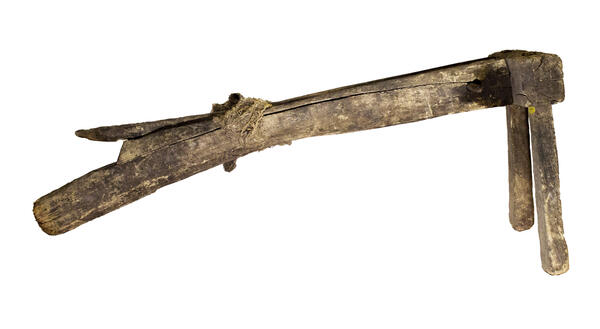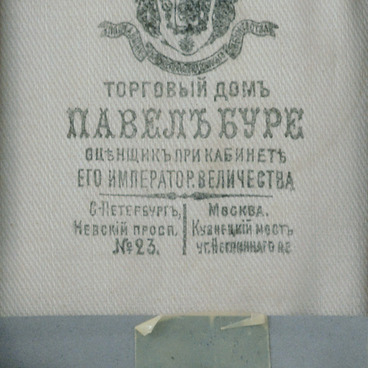In the old days, home weaving was one of the most common crafts in central Russia. It was necessary to process the vegetable fiber especially to make linen or hemp fabric.
The processing included several stages: threshing, soaking, crumpling, fluttering, carding, spinning, winding, weaving, and bleaching. The plant stems were dried, threshed, cleaned of seeds, soaked in water to wash off the substances that glue the fibers together, and then crushed — the fiber was separated from the wood.
The lignified parts of the stems, which were not suitable for making fabric, were called shives. The shives were almost 80% of the entire sheaf, so only a fifth of all the collected stems was used for the fabric.
The fiber obtained as a result of soaking was processed with homemade wooden breakers, slotted or circular. The exhibition presents a slotted breaker made presumably in the 1920s and 1930s.
Slotted breakers were made from hewn logs or from uprooted trees. In the old times, this was the name of a tree dug up together with the roots. One or two gaps were hollowed out in the trunk, then a moving part was attached to it — “beater”. Two roots acted as legs for the breaker.
A simplified version of this tool was the so-called composite breaker. It was a bar with a hollowed-out slot and mortise legs on one or two sides. The legs in the displayed exhibit were preserved on one side, and there was only a groove for fixing them on the other side.
The fiber was laid on the working part closer to the handle to break it. It was moved around the slot with a left hand, and with a right hand, the beater was quickly lowered and raised. It was necessary to press it with effort, so the fiber would go deeper into the gap and grind better at the bend. Occasionally, the fiber was pulled out of the breaker and tapped on the beater to shake off the remaining shives. The fiber was clamped in a crusher after that, pulled out from the beater, and combed. The fiber was straightened and smoothed, and the remaining parts of the stem were cleaned from the surface.
The process of making plant tissue was very laborious and took a lot of time. As a rule, the finished material was entirely used for the needs of the family; it was sold only in case of extreme need.
The processing included several stages: threshing, soaking, crumpling, fluttering, carding, spinning, winding, weaving, and bleaching. The plant stems were dried, threshed, cleaned of seeds, soaked in water to wash off the substances that glue the fibers together, and then crushed — the fiber was separated from the wood.
The lignified parts of the stems, which were not suitable for making fabric, were called shives. The shives were almost 80% of the entire sheaf, so only a fifth of all the collected stems was used for the fabric.
The fiber obtained as a result of soaking was processed with homemade wooden breakers, slotted or circular. The exhibition presents a slotted breaker made presumably in the 1920s and 1930s.
Slotted breakers were made from hewn logs or from uprooted trees. In the old times, this was the name of a tree dug up together with the roots. One or two gaps were hollowed out in the trunk, then a moving part was attached to it — “beater”. Two roots acted as legs for the breaker.
A simplified version of this tool was the so-called composite breaker. It was a bar with a hollowed-out slot and mortise legs on one or two sides. The legs in the displayed exhibit were preserved on one side, and there was only a groove for fixing them on the other side.
The fiber was laid on the working part closer to the handle to break it. It was moved around the slot with a left hand, and with a right hand, the beater was quickly lowered and raised. It was necessary to press it with effort, so the fiber would go deeper into the gap and grind better at the bend. Occasionally, the fiber was pulled out of the breaker and tapped on the beater to shake off the remaining shives. The fiber was clamped in a crusher after that, pulled out from the beater, and combed. The fiber was straightened and smoothed, and the remaining parts of the stem were cleaned from the surface.
The process of making plant tissue was very laborious and took a lot of time. As a rule, the finished material was entirely used for the needs of the family; it was sold only in case of extreme need.



